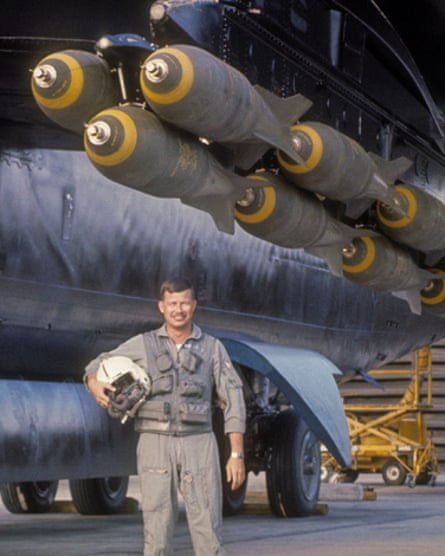OhOn September 1, 1974, two men made the fastest journey ever made between New York and London. The astonishing trip, at three times the speed of sound, took less than two hours and set a record that still stands 50 years later.
Even the mighty Concorde, which set the record for the fastest transatlantic commercial flight in 1996, lagged behind by almost an hour.
The US Air Force Lockheed Blackbird SR-71 aircraft had a two-man crew – pilot James Sullivan and reconnaissance systems operator Noel Widdifield – who completed the journey between the two cities in one hour, 54 minutes and 56 seconds before landing triumphantly to a welcoming fanfare at the Farnborough airshow in Hampshire.
Widdifield, now 83, divides his time between Virginia and Florida in the United States. “In some ways it was a normal flight for us,” he said, reflecting on that momentous day. “There was nothing different about it or the way we flew the plane. But in July 1974 we had been told that we would attempt to break the world record for the flight between New York and London, which had previously been set by Royal Navy pilots. There was a lot of media interest.”
It wasn’t just the Air Force’s bragging rights that were at stake. The United States was in the midst of something of an international public relations crisis: just three weeks earlier, disgraced President Richard Nixon had resigned in the wake of the Watergate scandal and Gerald Ford had taken over the White House. The country’s disastrous involvement in the Vietnam War still lingered in its aftermath. The country needed something to celebrate.
There were other machinations, too. Widdifield told the paper Observer“We knew nothing of this at the time, but behind the scenes there had been negotiations between the US and the UK to base the SR-71 Blackbirds on British soil.
“There was some concern in Britain about this decision, as it was thought that it might cause unrest, especially in the Middle East. But after we broke the record and took part in the Farnborough air show, that seemed to seal the deal and the UK allowed the SR-71s to be based there.”
Widdifield was 33 when he made the historic flight. He originally wanted to be a train driver, but when he was 12, when he saw a US Air Force plane flying over his home, he decided he would be a pilot.
After training and flying B-52 bombers, Widdifield joined the SR-71 Blackbird program at Beale Air Force Base in California from 1971 to 1975, after which he stopped flying and became involved in the U.S. space program until 1982.
Flying the Blackbird was like being an astronaut. The crew wore space suits and flew at an altitude of 80,000 feet (the maximum approved altitude for most commercial aircraft is 42,000 feet). Widdifield said: “The sky up there is black. You can see the stars and the moon or the sun, depending on the time of day.”
His plane took off from Beale and had to fly down the coast to New York to avoid causing a sonic boom over populated areas and extensive property damage. High above the city was an invisible “gate,” which would mark the start of the journey. Reaching speeds of Mach 3.2 (three times the speed of sound and approximately 2,455 mph), the Blackbird burst through the gate and the record attempt was underway.
The plane had to refuel twice: on takeoff, to connect with a refueling plane over California to fill it to capacity, and partly during the trip near Greenland.
There was also an incident that would have seemed terrifying from the outside, but which the crew took in stride. The Blackbird suddenly began to “yaw” – that is, to move rapidly from side to side – after losing propulsion.
The Blackbird drew air from the front to power the engines, and it was common for a device on the intake to become dislodged, causing one of the engines to momentarily lose much of its power.
After the newsletter promotion
Widdifield said: “The automatic restart systems kicked in, repositioned the cone that had gone off course and the engine restarted. It was not a particular concern, other than the effect it might have on the record speed race.”
The plane passed through the London “gate” without further incident and the Blackbird arrived at Farnborough, where a large crowd was waiting and a press conference was held, during which Widdifield and Sullivan spoke by phone to the new president. “There was a lot of international coverage for a year afterwards,” says Widdifield, who has six scrapbooks. “However, one thing Jim and I always tried to emphasise was that although it was the two of us who took the glory, there was a great team behind every flight.
“If you take into account all the support staff, the administrative workers and everyone else who does their part to keep us flying, that’s a thousand people. They deserve the same recognition as Jim and I.”
Widdifield, who has been married to his wife, Ann, for 63 years and has two children, five grandchildren and two great-grandchildren, mourns the loss of both his co-pilot Jim Sullivan, who died in 2021, and the Blackbird SR-71 itself, which was officially retired from service in 1998.
He said: “Jim and I kept in touch, but later only saw each other a few times at SR-71 meetings, as we lived so far away.
“Of course, I was sad to see the SR-71 program end. And am I surprised that no one has broken our record in 50 years? No. Because no other aircraft has been developed since then that could beat it.”

